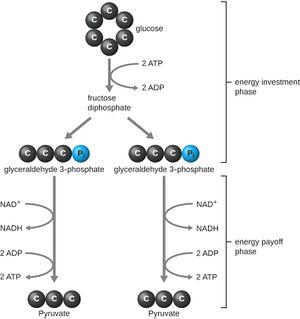Lactate Threshold: Difference between revisions
No edit summary |
No edit summary |
||
| (6 intermediate revisions by 2 users not shown) | |||
| Line 1: | Line 1: | ||
<div class="editorbox"> | <div class="editorbox"> | ||
'''Original Editor '''- [[Lucinda hampton|lucinda hampton]] | '''Original Editor '''- [[User:Lucinda hampton|lucinda hampton]] | ||
'''Top Contributors''' - {{Special:Contributors/{{FULLPAGENAME}}}} | '''Top Contributors''' - {{Special:Contributors/{{FULLPAGENAME}}}} | ||
</div> | </div> | ||
== Introduction == | == Introduction == | ||
[[File:Glycolysis simple.jpg|alt=|thumb|'''Anaerobic lactate production''']] | |||
Lactate threshold defined thus: The level above which pyruvate—an intermediate product of anaerobic metabolism—is produced faster than it can be used aerobically; unused pyruvate splits into lactate (lactic acid) and positively charged hydrogen ions; continued exercise above the lactate, or anaerobic, threshold results in accumulation of these ions—acidosis—causing exhaustion and intramuscular pain<ref>The fee dictionary [https://medical-dictionary.thefreedictionary.com/lactate+threshold lactate Threshold] Available: https://medical-dictionary.thefreedictionary.com/lactate+threshold<nowiki/>(accessed 28.11.2021)</ref> | |||
Many refer to lactate as a metabolic waste product (not really) and blame it for the muscle soreness that can plague us several days after a hard workout (not so, actually inflammation)<ref name=":0">Active [https://www.active.com/triathlon/articles/lactate-threshold-and-v02-max-explained Lactate Threshold and V02 Max Explained] Available: https://www.active.com/triathlon/articles/lactate-threshold-and-v02-max-explained<nowiki/>(accessed 28.11.2021)</ref>.Still, exercise above the lactate threshold is associated with more rapid fatigue and, as such, the speed at lactate threshold is a powerful predictor of endurance performance. | Many refer to lactate as a metabolic waste product (not really) and blame it for the [[Muscle Fatigue|muscle soreness]] that can plague us several days after a hard workout (not so, actually [[Inflammation Acute and Chronic|inflammation]])<ref name=":0">Active [https://www.active.com/triathlon/articles/lactate-threshold-and-v02-max-explained Lactate Threshold and V02 Max Explained] Available: https://www.active.com/triathlon/articles/lactate-threshold-and-v02-max-explained<nowiki/>(accessed 28.11.2021)</ref>. Still, exercise above the lactate threshold is associated with more rapid fatigue and, as such, the speed at lactate threshold is a powerful predictor of endurance performance. | ||
A higher lactate threshold will enable | A higher lactate threshold will enable an endurance activity to be sustained without blood lactate accumulating, enabling the athletes speed to be maintained for an extended period. eg Elite male and female marathon runners have reported lactate threshold speeds of 18-21km/h<ref>The Conversation Science of champion runners: inside the body of elite endurance athletes Available: https://theconversation.com/science-of-champion-runners-inside-the-body-of-elite-endurance-athletes-146639<nowiki/>(accessed 28.11.2021)</ref> | ||
== | == Mechanism == | ||
The lactate threshold is a point during exhaustive, all-out exercise at which lactate builds up in the bloodstream faster than the body can remove it. The only way to make up the difference is to rev up anaerobic glycolysis. | [[File:Athlete.jpeg|right|frameless]] | ||
The lactate threshold is a point during exhaustive, all-out exercise at which lactate builds up in the [[Blood Physiology|bloodstream]] faster than the body can remove it. The only way to make up the difference is to rev up [[Anaerobic Capacity|anaerobic glycolysis]], which occurs in environments environments lacking oxygen. | |||
* Anaerobic | * Anaerobic metabolism produces energy for short, high-intensity bursts of activity, the lactate build-up reaches a threshold where it can no longer be absorbed and accumulates. This point is known as the lactate threshold | ||
* Lactate, which may be harmful to the cell itself [[Aerobic Exercise|(aerobic]] glycolysis is water and carbon dioxide, which are not harmful to cells). | |||
* When the concentration of lactate in the blood starts to climb, our [[Brain Anatomy|brain]] senses this and we start to feel nauseous.<ref name=":0" /><ref name=":1">verywellfit Lactate Threshold Training for Athletes Available: https://www.verywellfit.com/lactate-threshold-training-3120092 (accessed 28.11.2021)</ref> | |||
See Metabolic Acidosis in [[Arterial Blood Gases]] | |||
== Lactate Threshold Values == | |||
A plot of lactate concentration vs. percentage of V02 max is produced and the lactate threshold is identified as the point of inflection, as demonstrated in the graph<ref name=":0" /> | |||
# Average person: 60% of VO2 max | |||
# Recreational athlete: 65% to 80% of VO2 max | |||
# Elite endurance athlete: 85% to 95% of VO2 max2<ref name=":1" /> | |||
== VO 2 max == | |||
Another way to measure maximum effort is [[VO2 Max|VO2 max]]. VO2 max is the maximum consumption of oxygen that your body can take in and use while exercising. That ability to take in and use oxygen is an indicator of your cardiorespiratory fitness level.<ref name=":1" /> | |||
== References == | == References == | ||
Latest revision as of 02:34, 16 August 2022
Original Editor - lucinda hampton
Top Contributors - Lucinda hampton and Kim Jackson
Introduction[edit | edit source]
Lactate threshold defined thus: The level above which pyruvate—an intermediate product of anaerobic metabolism—is produced faster than it can be used aerobically; unused pyruvate splits into lactate (lactic acid) and positively charged hydrogen ions; continued exercise above the lactate, or anaerobic, threshold results in accumulation of these ions—acidosis—causing exhaustion and intramuscular pain[1]
Many refer to lactate as a metabolic waste product (not really) and blame it for the muscle soreness that can plague us several days after a hard workout (not so, actually inflammation)[2]. Still, exercise above the lactate threshold is associated with more rapid fatigue and, as such, the speed at lactate threshold is a powerful predictor of endurance performance.
A higher lactate threshold will enable an endurance activity to be sustained without blood lactate accumulating, enabling the athletes speed to be maintained for an extended period. eg Elite male and female marathon runners have reported lactate threshold speeds of 18-21km/h[3]
Mechanism[edit | edit source]
The lactate threshold is a point during exhaustive, all-out exercise at which lactate builds up in the bloodstream faster than the body can remove it. The only way to make up the difference is to rev up anaerobic glycolysis, which occurs in environments environments lacking oxygen.
- Anaerobic metabolism produces energy for short, high-intensity bursts of activity, the lactate build-up reaches a threshold where it can no longer be absorbed and accumulates. This point is known as the lactate threshold
- Lactate, which may be harmful to the cell itself (aerobic glycolysis is water and carbon dioxide, which are not harmful to cells).
- When the concentration of lactate in the blood starts to climb, our brain senses this and we start to feel nauseous.[2][4]
See Metabolic Acidosis in Arterial Blood Gases
Lactate Threshold Values[edit | edit source]
A plot of lactate concentration vs. percentage of V02 max is produced and the lactate threshold is identified as the point of inflection, as demonstrated in the graph[2]
- Average person: 60% of VO2 max
- Recreational athlete: 65% to 80% of VO2 max
- Elite endurance athlete: 85% to 95% of VO2 max2[4]
VO 2 max[edit | edit source]
Another way to measure maximum effort is VO2 max. VO2 max is the maximum consumption of oxygen that your body can take in and use while exercising. That ability to take in and use oxygen is an indicator of your cardiorespiratory fitness level.[4]
References[edit | edit source]
- ↑ The fee dictionary lactate Threshold Available: https://medical-dictionary.thefreedictionary.com/lactate+threshold(accessed 28.11.2021)
- ↑ 2.0 2.1 2.2 Active Lactate Threshold and V02 Max Explained Available: https://www.active.com/triathlon/articles/lactate-threshold-and-v02-max-explained(accessed 28.11.2021)
- ↑ The Conversation Science of champion runners: inside the body of elite endurance athletes Available: https://theconversation.com/science-of-champion-runners-inside-the-body-of-elite-endurance-athletes-146639(accessed 28.11.2021)
- ↑ 4.0 4.1 4.2 verywellfit Lactate Threshold Training for Athletes Available: https://www.verywellfit.com/lactate-threshold-training-3120092 (accessed 28.11.2021)








